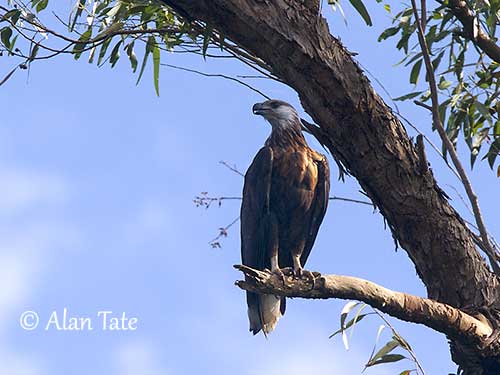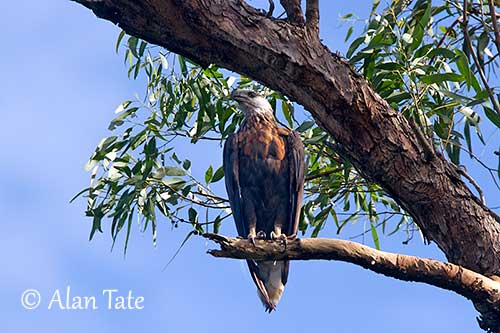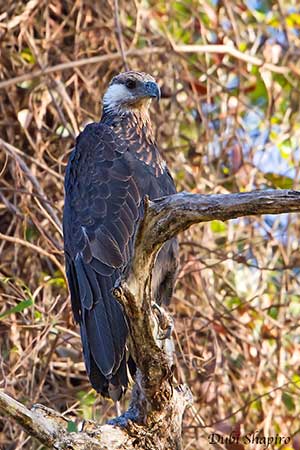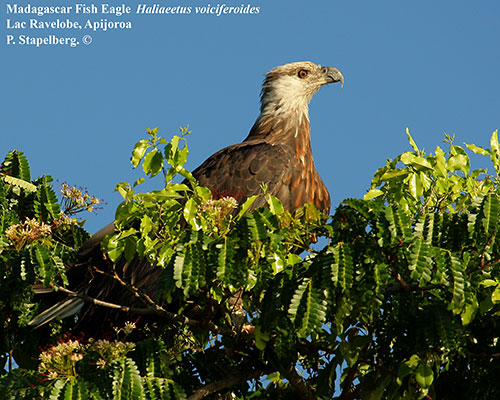
PROTECTION / THREATS / STATUS:
The Madagascan Fish-Eagle has restricted range in which it is threatened by deforestation and development of rice-paddles causing loss of both nesting and foraging habitats, shooting by local people for food and use in traditional medicine, disturbance at breeding sites and pet trade.
It has very small population with around 240 mature individuals, equating roughly to 360 individuals in total. However, this population appears currently stable or with moderate decline.
The Madagascan Fish-Eagle is currently classified as Critically Endangered.
Fr: Pygargue de Madagascar
Ang: Madagascar Fish-Eagle
All: Madagaskarseeadler
Esp: Pigargo Malgache
Ita: Aquila pescatrice del Madagascar
Nd: Madagaskarzeearend
Sd: madagaskarhavsörn
Mal: Ankoay
Photographers:
Dubi Shapiro
Dubi Shapiro Photo Galleries
Philip Stapelberg
GALLERY
Alan & Ann Tate
AA Bird Photography
Text by Nicole Bouglouan
Sources :
HANDBOOK OF THE BIRDS OF THE WORLD Vol 2 by Josep del Hoyo-Andrew Elliot-Jordi Sargatal - Lynx Edicions - ISBN: 8487334156
BIRDS OF PREY OF AFRICA AND ITS ISLANDS by Alan and Meg Kemp - Struik Publishers - ISBN: 1770073698
The Birds of Africa: Volume VIII: The Malagasy Region: Madagascar, Seychelles, Comoros, Mascarenes - Par Roger Safford, Frank Hawkins – ISBN: 1408190494, 9781408190494- Editeur: A&C Black, 2013
RAPTORS OF THE WORLD by James Ferguson-Lees et David Christie - Helm Identification Guides – ISBN: 0713680261
The Peregrine Fund – World Centre for Birds of Prey
Wikipedia, the free encyclopaedia
Global Raptor Information Network - Working to Conserve Birds of Prey in nature
EDGE – Evolutionary Distinct & Globally Endangered
SORA - Madagascar Fish-Eagle prey preference and foraging success
Related article: Fish-Eagles, feeding behaviour
Madagascan Fish-Eagle
Haliaeetus vociferoides
Accipitriformes Order – Accipitridae Family
INTRODUCTION:
The Madagascan Fish-Eagle is endemic of this island where it occurs in a coastal strip in NW Madagascar. This eagle ranges within the dry, deciduous forests and forages on sea-shores, lakes and rivers. It feeds primarily on fish and directly competes with local fishermen.
The Madagascan Fish-Eagle is one of the rarest raptors of the world. It is threatened by persecution, disturbance at breeding sites, shooting for food and traditional medicine, and pet trade. The deforestation and changes in wet areas involve loss of nesting and foraging habitats.
This species has small population and is currently classified as Critically Endangered.
DESCRIPTION OF THE BIRD:
Biometrics:
Length: 60-66 cm
Wingspan: 165-180 cm
Weight: M: 2200-2700 g – F: 2800-3500 g
The Madagascan Fish-Eagle is the largest raptor of Madagascar. The plumage is brown overall and contrasts with the white tail, especially in flight. The flight-feathers are dark sooty brown.
On the underparts, upper breast and underwing-coverts are brown with broad, rufous streaks. The lower breast is uniformly dark brown.
Head, nape and neck sides show broad, creamy-white streaks, whereas ear-coverts and cheeks are white and the throat is pale buff. We can see a dark streak through the eye.
The hooked bill is black with blue-grey cere. The eyes are brown. The strong, bare legs and the feet are whitish.
Male and female have similar plumage, but the female is 4-9% larger than male.

The juvenile has paler brown plumage with buff-edged feathers on body, whereas head, neck and breast are streaked buff. Lower breast and vent are uniformly dark brown. The tail is brown with some white mottling on outer rectrices.
On the head, ear-coverts, throat and eyebrow are unmarked.
The adult plumage is complete through the 5th year.
RANGE:
The Madagascan Fish-Eagle was previously found all over the island, but is occurs now only in coastal NW Madagascar.
HABITAT:
The Madagascan Fish-Eagle frequents the dry-deciduous forests, but also aquatic habitats. It can be seen on seashores, islands, lakes and rivers, mainly with wooded margins, especially with large trees for hunting and scanning for prey in the water. It nests in mangroves or on cliffs, and lives at sea-level.
CALLS AND SONGS:
The Madagascan Fish-Eagle is very vocal all year round. Like the closely related African Fish-Eagle, it gives loud, shrill “ko ko koy-koy-koy-koy-koy” repeated as short intervals. This call is given with the head thrown back, from a perch or in flight.
Male and female may duet perched side by side. The male’s calls are higher-pitched than those of female, but both are audible at more than 1 kilometre.
The chicks have higher-pitched calls than adults.

The Madagascan Fish-Eagle is usually seen in pairs. Courtship and nest-building begin in May. Displays are both vocal and aerial. They are monogamous and territorial. Both mates build a large stick nest. Male and female share the nesting duties.
Co-operative breeding and polyandry with all attendant males copulating with the female have been recorded. From recent studies, 1-3 extra-pair birds were very close to the breeding pair. These birds were probably progeny from previous year. They took briefly part in incubation, chick care and provisioning at two nests.
The Madagascan Fish-Eagle is sedentary, but immatures disperse and wander up to 200 kilometres.
It flies with deep, steady wingbeats, but it is more often seen soaring on large wings.
REPRODUCTION OF THIS SPECIES:
The laying occurs between late May and mid-July, and may extend sometimes until December.
The Madagascan Fish-Eagle builds a typical large stick nest lined with green leaves. It is placed in the fork of large tree, often in mangroves, but also on cliffs on rocky islands, usually 6-8 metres above the ground. Nest material is often added throughout the breeding season.
The female lays 1-2 eggs several days apart. The incubation is mainly by female during 38-42 days. She is provisioned by the male during this period.
At hatching, the chicks have white down. Only one chick survives. The smaller one often dies by starvation. The remaining bigger chick grows quickly. It begins to reach the surrounding branches around 70 days, prior to fledging at about 80 days old. It flies for the first time after several days exercising its wings, making short flights or hopping from branch to branch.
PROTECTION / THREATS / STATUS:
The Madagascan Fish-Eagle has restricted range in which it is threatened by deforestation and development of rice-paddles causing loss of both nesting and foraging habitats, shooting by local people for food and use in traditional medicine, disturbance at breeding sites and pet trade.
It has very small population with around 240 mature individuals, equating roughly to 360 individuals in total. However, this population appears currently stable or with moderate decline.
The Madagascan Fish-Eagle is currently classified as Critically Endangered.

BEHAVIOUR IN THE WILD:
As indicated by its name, the Madagascan Fish-Eagle feeds primarily on fish, both native and introduced species. The main prey are 25-35 centimetres long. They are usually surface-dwelling fish, taken close to the surface, about 15 centimetres of depth. It hunts from perches over water.
However, it also takes crabs, turtles and birds, mainly domestic livestock such as duck and turkey chicks, and occasionally carrion.
The Madagascan Fish-Eagle spends long periods perched, but it sometimes soars high in the air over the territory. It roosts in large trees near the shore.
It hunts by plunge-dive and catches prey from water surface or just below, or by dropping onto the prey during a soaring flight. It often returns to the same perch to eat the prey, or sometimes eats the fish on the ground, mainly the large ones. It may pirate food for waterbirds.
